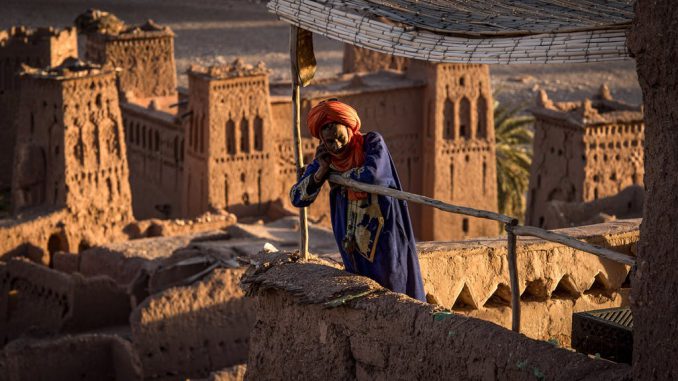
At the gates of the Moroccan desert, on the foothills of the High Atlas, stands a postcard fortified village, Ait-ben-Haddou. Behind its ocher-colored walls, many iconic films and series, such as Game of Thrones, have been filmed.
In this UNESCO World Heritage site, overlooking a valley, time seems to have stood still.
About thirty kilometers from the studios of Ouarzazate, the “Mecca” of cinema in Morocco, Aït-ben-Haddou is the most famous of the ksars of southern Morocco, a group of collective earthen dwellings.
Entering the ksar’s impressive gateway, an endless labyrinth of winding alleys and narrow streets leads to a square where the inhabitants used to gather in the past.
The village, which is high up, still has a mosque, an attic and two cemeteries, one for Muslims and one for Jews. Most of the inhabitants have left and some of their houses have since been converted into craft shops.
This unusual architectural complex forms an idealistic setting for the seventh art. From Lawrence of Arabia to The Mummy to the Gladiator Peplum, the ksar has hosted several major blockbusters.
The site has also housed scenes from Game of Thrones. Aït-ben-Haddou became the fictional city of Yunkai, which Daenerys Targaryen, a leading character of the “GoT” universe, managed to conquer.
Hammadi, 61 years old, is a privileged witness of this cinematographic craze. “All these works have contributed to the fame of the region,” he confides with a big smile.
He himself has been featured in a number of films. And although he has taken up residence in a more modern village on the other side of the valley, like most of the inhabitants of the ksar, he continues to return there to organize visits for tourists.
On a wall at the entrance to Hammadi’s old house, photos bear witness to the films in which he participated. We can see him in ancient Roman costume, alongside director Ridley Scott, during the filming of Gladiator.
“We have a rich film heritage that we hope to use to attract tourists,” says Ahmed, a 29-year-old tour guide.
But the young man would like his village to become a little more of a showcase for the prestigious projects he has hosted, if only by putting up signs.
“There’s no indication that Game of Thrones was filmed here,” he regrets.
On the Atlantic coast of Morocco, the city of Essaouira has also hosted scenes from “GoT”. But again, the tourism sector has not capitalized on this.
Unlike Northern Ireland, Malta or Dubrovnik, which have been widely promoting “GoT” shootings that have taken place on their soil and have attracted hordes of fans of the series from all over the world.
To overcome this, Ahmed and other young people from the village are working with the means at hand to create a museum of photography in the heart of the ksar, where images from the filming are gathered.
The museum may exist before “GoT” returns to the village: the American television channel HBO has commissioned a prologue entitled House of the Dragon. And George R. R. Martin, the author of the books from which the series is based, has said on his blog that Morocco would be one of the filming locations.

Be the first to comment